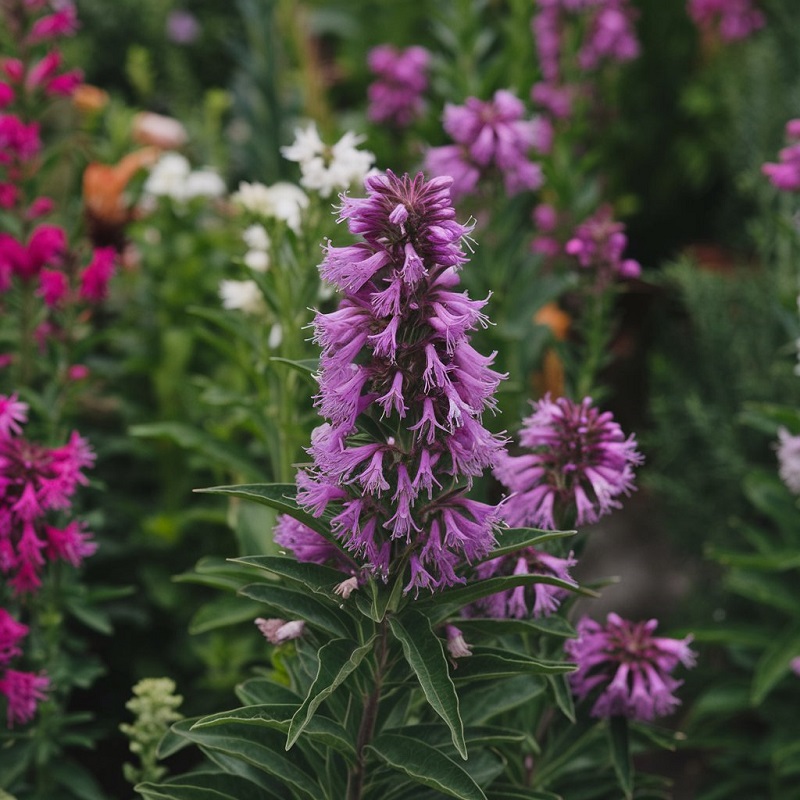You planted lemon bee balm plant with care, watched it grow taller by the day, admired its lush green leaves—and still, no flowers. Sound familiar? You’re not alone.
Lemon bee balm—also known as Monarda citriodora—is a popular choice for gardens thanks to its lemony scent, bright purple-pink flowers, and its knack for attracting bees, butterflies, and even hummingbirds. But when it looks healthy and still won’t bloom, something’s definitely not quite right.
Let’s dig into the most common reasons this happens—and what you can do right now to bring those beautiful blooms to life.
Meet the Lemon Bee Balm plant
Before we troubleshoot, here’s a quick intro:
- Botanical name: Monarda citriodora
- Also called: Lemon mint, purple horsemint, or just horsemint
- Native to: Central and southern U.S., especially Texas
- Ideal zones: USDA 3–9
- Typical bloom time: Late spring to early summer
Being a member of the mint family, lemon bee balm grows fast, smells amazing, and can spread pretty easily if left unchecked. When it’s happy, you’ll see clusters of vivid purple flowers shooting upward—irresistible to pollinators.
Warning Signs Before Bloom Failure
Before your bee balm gives up on flowering entirely, it often sends out small red flags. Catching them early can save you time and trouble.
What to Watch For:
| Symptom | Possible Cause |
| Yellowing leaves | Overwatering or poor soil drainage |
| Droopy or wilting stems | Underwatering or root stress |
| White or spotted leaves | Fungal issues like powdery mildew |
| No buds at all | Not enough sun or too much nitrogen |
| Crispy brown edges | Windburn or salt buildup |
| Stunted growth | Compacted soil or root problems |
What You Can Do:
- Check if the soil is too wet or too dry
- Look closely under the leaves for insects
- See if nearby plants are competing for space or nutrients
- If problems persist, test your soil’s pH and nutrient content
Bonus: Natural Pest Control Benefits
Did you know lemon bee balm plant does more than just look pretty? Its strong lemony-mint scent helps repel garden pests like mosquitoes, aphids, and spider mites. The essential oils it produces are similar to citronella and thymol—both known for their insect-repelling properties.
Try This:
- Plant around veggie beds to keep pests away
- Mix in with tomatoes or squash to confuse bugs
- Dry the leaves and make your own pest-repellent sachets
7 Reasons Your Lemon Bee Balm Isn’t Blooming
- Not Enough Sun
Bee balm loves sunlight. Without 6 to 8 hours of direct sun daily, it may grow tall and leafy—but never flower.
Fix it: Move it to a sunnier spot or trim back overhanging branches.
- Too Much Nitrogen
Nitrogen helps with leafy growth, but too much of it can mean zero blooms.
Fix it: Use a balanced fertilizer or one with more phosphorus. Look for labels like 5-10-5 or 10-10-10.
- Watering Problems
Overwatering can rot the roots. Underwatering causes stress. Either way, no flowers.
Fix it: Water deeply, but only when the top inch of soil feels dry. Add mulch to help retain moisture.
- Soil Struggles
If your soil doesn’t drain well or has an off pH, your plant won’t be happy.
Fix it: Mix in compost, and consider adding perlite or sand. Test your soil if you’re unsure.
- Stress or Disease
Bee balm is tough—but not invincible. Fungal diseases or insect damage can mess with blooming.
Fix it: Trim off damaged parts, use neem oil or natural sprays, and water at the base to prevent mildew.
- Wrong Timing on Pruning
Pruning at the wrong time can actually remove developing buds.
Fix it: Prune in early spring and deadhead spent blooms throughout summer. Avoid cutting it all down before winter.
- It’s Still a Baby
If you grew your bee balm from seed, it might need a season or two before flowering.
Fix it: Be patient! Or plant a more mature one next time if you want faster results.
Fast Fix: What to Do Right Now
Here’s a quick action plan to help your lemon bee balm bloom again—fast.
Step 1: Check the Sun
Use a gardening app or just observe for a few days—does your plant get full sun?
Step 2: Feed It Wisely
Switch to a bloom-friendly fertilizer and skip the high-nitrogen ones.
Step 3: Adjust Your Watering
Water deeply once or twice a week, not daily. Use mulch to even things out.
Step 4: Look for Pests or Disease
Turn over leaves, check near the base, and treat any issues as soon as you spot them.
Step 5: Improve Soil
Mix in compost, break up any compact areas, and test pH if you’re stuck.
Keep Your Plant Happy Year-Round
Seasonal Bee Balm Checklist
| Season | What to Do |
| Spring | Light pruning, fertilize, divide if it’s crowded |
| Summer | Water regularly, deadhead, watch for pests |
| Fall | Clean up dead stems, add compost |
| Winter | Mulch in cold areas—don’t prune until spring |
Companion Planting Tips
Pair lemon bee balm with:
Good neighbors:
- Yarrow
- Coneflower
- Lavender
- Salvia
Not-so-great companions:
- Other mint-family plants (they’ll fight for space and nutrients)
FAQs: Lemon Bee Balm Not Blooming
Q1. Does lemon bee balm need full sun to flower?
Yes! Without 6–8 hours of direct light, it probably won’t bloom well.
Q2. Should I cut it back after flowering?
Absolutely—deadheading can bring on more blooms later in the season.
Q3. How long does it take to bloom from seed?
Usually 2–3 months, though some plants skip flowering the first year.
Q4. Can it grow in pots?
Yes, just make sure the pot drains well and gets full sun. Don’t let it dry out!
Q5. What are signs of too much fertilizer?
Lots of leaves, few (or no) flowers, burnt tips, and crusty soil are big clues.
Final Takeaways
- Lemon bee balm blooms best with full sun, well-draining soil, and low-to-medium fertilizer levels.
- If your plant looks healthy but isn’t blooming, check light, nutrients, and moisture first.
- Don’t forget: this plant pulls double duty by attracting pollinators and deterring pests.
- Treat it well, and it’ll reward you with a burst of color and buzz every summer.
Still no flowers? Snap a pic, jot down your symptoms, and drop us a comment—we’ll help you troubleshoot. Or check out our full growing guide to lemon bee balm from seed.
Want a free bloom-boosting checklist? Subscribe to our newsletter and get expert tips straight to your inbox!





